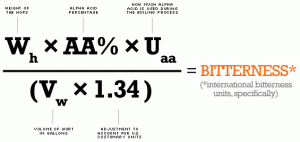Whenever I go to a French restaurant (which, let’s be honest, is not all that often) I feel immediately intimidated by the real cloth napkins and, more importantly, the menu. I always end up ordering something with mushrooms in it, because champignons is my favorite French word. And parapluie, but they rarely offer umbrellas at those places.
I know for some a beer menu can seem to be in a foreign language, too, so I thought I’d start a series in which I translate a few of the trickier bits of beer lingo.
Let’s start with the ABV, which stands for Alcohol by Volume. This is often found as a percentage on the menu listing and describes how alcoholic or strong the drink is. This number means very little to me in a science-y sort of way, but I know what the percentages mean in a how-fast-you’ll-feel-drunk sort of way. Boring old Buds and Millers, etc are generally in the 3.5% to 4.5% range. They are not very alcoholic. I can only imagine this is why people buy it by the truckload. Five to six percent is fairly average with anything above seven being ones to be careful with, that is to drink slowly or forever hold your tongue.
Another somewhat alarming descriptor often used on a beer menu is “Double” or “Imperial.” These beers are neither extra large nor particularly colonial, though they will storm your gord and make you speak a different tongue if you’re not careful. These terms describe BIG beers (“big” being another bit of beer lingo) meaning they have strong, complex flavors and high ABVs, usually 7% to 14%. Yikes! Doubles are made by doubling the malt etc to make double the alcohol, and the term Imperial stems from the Russian Imperial Stout style. From here everyone seems a bit confused or absurdly set in their opinion about whether these terms describe different styles of beers or the same kind. Whatever. Not important. They are very good and very strong.
Beer dudes love their acronyms, and IBU is my personal favorite; International Bittering Units. I mean, the jokes! This is a system for indicating hop bitterness in a beer. Generally speaking it goes from 1-100, 100 being sooper-dooper bitter, but some beers have pushed beyond that. It’s also kind of a pissing contest. I have a friend who’ll be like, “and it had 103 IBUs!” and I’ll be like, “I’m sure your penis is perfectly adequate.”
The last bit of beer lingo I have for you tonight is “dry hopped.” (Again with the jokes!) It’s a confusing term because it would seem that most beers have dried hops added to them. The only exceptions are the rare “wet hopped” beers, which have fresh-from-the-vine, not-yet-dried hops tossed in the mix. The term dry-hopped actually refers to the technique of adding hops to already-fermenting beer, rather than in the boiling wort. Through some chemistry or magic, the timing of this addition allows the floral, citrus, or herbal notes of the hops to come through in the final project without additional bitterness. It’s a good thing.
More lingo definitions in the future. Any bit of confusion you’d like investigated in particular? Until next time, bonne chance!

